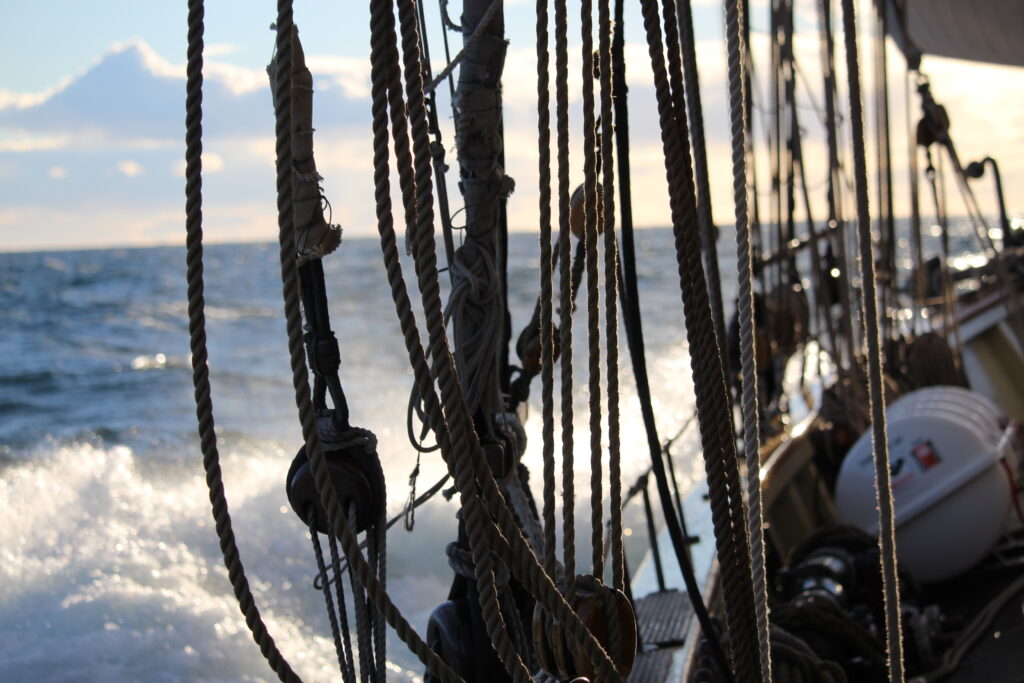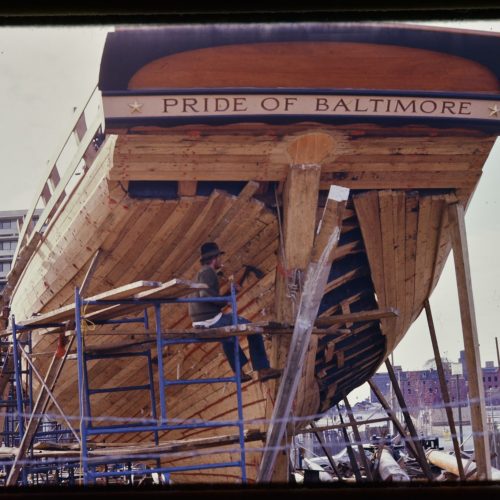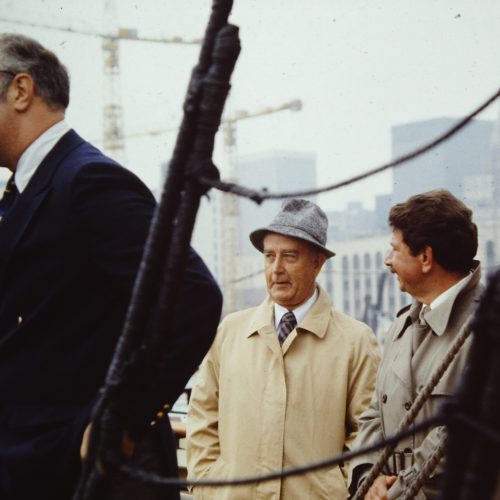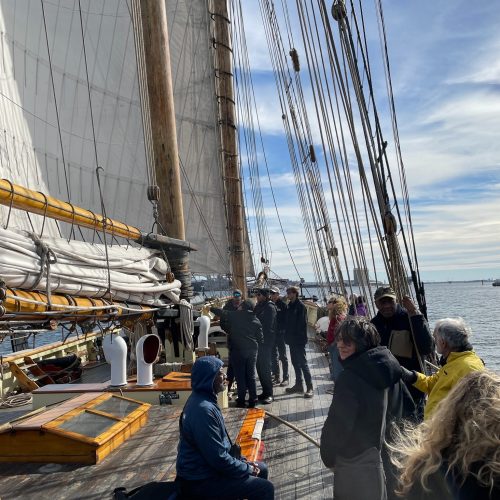Location: Moored at Schaefer’s Canal House Marina, Chesapeake City, Maryland
Voyage planing is first a calendar process. Meaning setting the itinerary for PRIDE OF BALTIMORE II. Developed by a number of factors. Charter fees from Tall Ship Festival Ports is a major one for this year. There can be port visits by PRIDE all by herself, within and without Maryland’s portion of the Chesapeake. Each transit between scheduled ports is given a number of calendar days appropriate for the distance between.
The plan for Boston to Baltimore met with a forecast gale in the Mid-Atlantic Region. It appeared there was flexibility to delay entry of Delaware Bay till after the gale ended. Meanwhile, the forecast strength of the gale was not extraordinary. Forty-knot gusts and ten-foot seas are not extraordinary. Clearly, such force is to be respected. For instance, strong winds directly from where PRIDE is intending to go is not viable. Not only because it is rough and risky to crew and not possible to advance PRIDE against by either sail or engines. There is ship damage risk if the long head-rig PRIDE has, totaling fifty feet beyond PRIDE’s bow, is plunged deeply into a wave. The head-rig behaves like a bending fishing pole when being dragged out from under the sea by the buoyancy of PRIDE’s bow. However, the two spars that make up the head-rig, bowsprit and jib-boom, do not have the range of flexibility to be found in a good fishing pole. Plunging deeply enough, or frequently enough with shallower plunges, will break PRIDE’s jib-boom. Might crack the bowsprit.
The forecast gale track and counter-clockwise characteristics would mean not being presented with contrary winds during the approach to Delaware Bay. Only favorable winds. Meaning winds from the northeast. Coming from behind PRIDE as she approached the Delaware Bay on her way from Buzzards Bay in Massachusetts. Given the forecast strength was not extraordinary and had been consistent with multiple forecasts covering almost a week, the forecast was given a high trust factor. Weakening the idea of avoiding, which could only be done by delaying, and possibly present undesirable challenges for keeping to the voyage plan timing.
Sailing PRIDE downwind is not as simple as it might read. For you sailors out there, dead or directly downwind sailing means only one sail gets the wind. The first sail the wind hits, can mean any sails to the forward experience a wind shadow. Meaning, do not get much wind. PRIDE’s mainsail presents a large wind shadow for the several sails forward. With this reality, we sail PRIDE on reaches that are directions to one side or another of dead downwind. Meaning the wind shadow is off to the side and not affecting the forward sails. This might require making a zigzag track toward the downwind destination. With wind from the northeast, PRIDE did indeed zigzag her way towards Delaware Bay.
After a while, there was more wind power than was sustainable without taking in more sail. So the loose-footed foresail was brailed. At sea with a plan to sail on and on, this sail would not be taken in. It is in the center of the sail plan. At 1,500 square feet, it is a powerful sail. When by itself, it pulls PRIDE rather than pushes her. Hence does not battle with the rudder for control of PRIDE. Can be reefed. But even reefed, gybing it is crew-intensive with strong winds. And gybing would be required to turn from the Atlantic into Delaware Bay. So, it was is best not have that loose-footed sail set. Brailing that loose-footed sail is not a simple thing with strong winds. After it was “handed in” with careful coordination of crew, lead by Captain Jeff Crosby, the remaining sails were staysail and jib, and reefed square topsail. After the foresail was taken in it became apparent that the jibs were not useful. The reefed square topsail was the main power sail. Without complications. Spread between two square yards, it would be easy for crew to trim as needed via the braces attached to the yards. Going more directly downwind meant the jibs were of little aid, especially as going faster was not a benefit. Remaining up would only mean possible damage through some unanticipated event. Before striking the jib, the already struck jib topsail was un-hanked from its stay and as a tightly secured long sausage, dragged aboard. All this to reduce any risk of a deep plunge of the head rig which could damage the jib topsail when stowed by itself on the jibboom while the jib was still set. Dropping the jib meant it would be alone on the jibboom. Pretty safe when tightly flaked (folded) on the jibboom. During all this, it was noted the wave action being experienced was already matching the max forecast of around 10 feet, with no sense conditions would exceed forecast. And the head-rig had not once been at risk of plunging. So it was decided a low risk for the jib and head-rig with jib left stowed on the jibboom all by itself. Also a reasonable strategy rather than the extended effort to trice the jib up. Meaning a tightly tied sausage roll hung by the jib halyard transferred to the clew of the jib & the sausage stretched upwards.
Entry to Delaware Bay with winds between 30-40 knots and seas upwards of 10 feet had PRIDE moving in jerks and twists that kept all aboard bracing themselves. Sometimes rolling deep to one side and sinking the bulwark down under a wave. The rolling was pretty short duration. So the amount of water boarded was not huge. This occurred only amidships. Crew on watch were back aft. Higher than is amidship. A lot dryer save for spray of an occasional splashy crest.
Once around the corner and headed up Delaware Bay, still experiencing winds of 30+ knots, with apparent wind now coming from the side, slightly forward of the beam, the reefed square-topsail was unable to provide enough forward drive to steer PRIDE up the channel. That lone sail did drive PRIDE forward. However, there was a lot of leeway from the side force of the still-strong wind. Engines were turned on and adjusted to 1,100 RPM. A moderate amount of power that pushed PRIDE along at 4-5 knots. Enabling steering PRIDE up the channel. The reefed square topsail now more a steadying sail that reduced rolling to a steady heel to leeward.
Around 0900 this morning, just before entering the C&D Canal, the reefed square-topsail was brailed up and crew climbed up to stow tightly. And the idea was hatched by Partner Captain Jeff Crosby to inquire with Schaefer’s Canal House Marina the chance to tie PRIDE there for the rest of this day and overnight. With that welcome, the after-lunch chores were de-salt down below. Once done, stand all hands down for the rest of the afternoon. Tonight ought to be a quiet night and a chance for quality, uninterrupted sleep.







